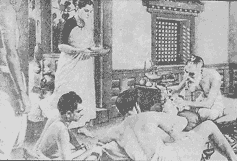Ancient scholars of India like Atreya, and Agnivesa have dealt with principles of Ayurveda as long back as 800 BC. Their works and other developments were consolidated by Charaka who compiled a compendium of Ayurvedic principles and practices in his treatise Charaka-Samahita, which remained like a standard textbook almost for 2000 years and was translated into many languages, including Arabic and Latin. 'Charaka-Samahita' deals with a variety of matters covering physiology, etiology and embryology, concepts of digestion, metabolism, and immunity. Preliminary concepts of genetics also find a mention, for example, Charaka has theorized blindness from the birth is not due to any defect in the mother or the father, but owes its origin in the ovum and the sperm.
In ancient India, several advances were also made in the field of medical surgery. Specifically these advances icluded areas like plastic surgery, extraction of catracts, and even dental surgery. Roots to the ancient Indian surgery go back to at least circa 800 BC. Shushruta, a medical theoretician and practitioner, lived 2000 years bebore, in the ancient Indian city of Kasi, now called Varanasi. He wrote a medical compendium called 'Shushruta-Samahita. This ancient medical compendium describes at least seven branches of surgery: Excision, Scarification, Puncturing, Exploration, Extraction, Evacuation, and Suturing. The compendium also deals with matters like rhinoplasty (plastic surgery) and ophthalmology (ejection of cataracts). The compendium also focuses on the study the human anatomy by using a dead body.
In ancient India Medical Science supposedly made many advances. Specifically these advances were in the areas of plastic surgery, extraction of cataracts, and dental surgery. There is documentary evidence to prove the existence of these practices.

Yoga is a system of exercise for physical and mental nourishment. The origins of yoga are shrouded in antiquity and mystery. Since Vedic times, thousand of years before, the principles and practice of yoga have crystallized. But, it was only around 200 BC that all the fundamentals of yoga were collected by Patanjali in his treatise, named Yogasutra, that is, Yoga-Aphorisms.
In short, Patanjali surmised that through the practice of yoga, the energy latent within the human body may be made live and released, which has a salubrious affect on the body and the mind. Now, in modern times, clinical practices have established that several ailments, including hypertension, clinical depression, amnesia, acidity, can be controlled and managed by yogic practices. The application of yoga in physiotherapy is also gaining recognition.
